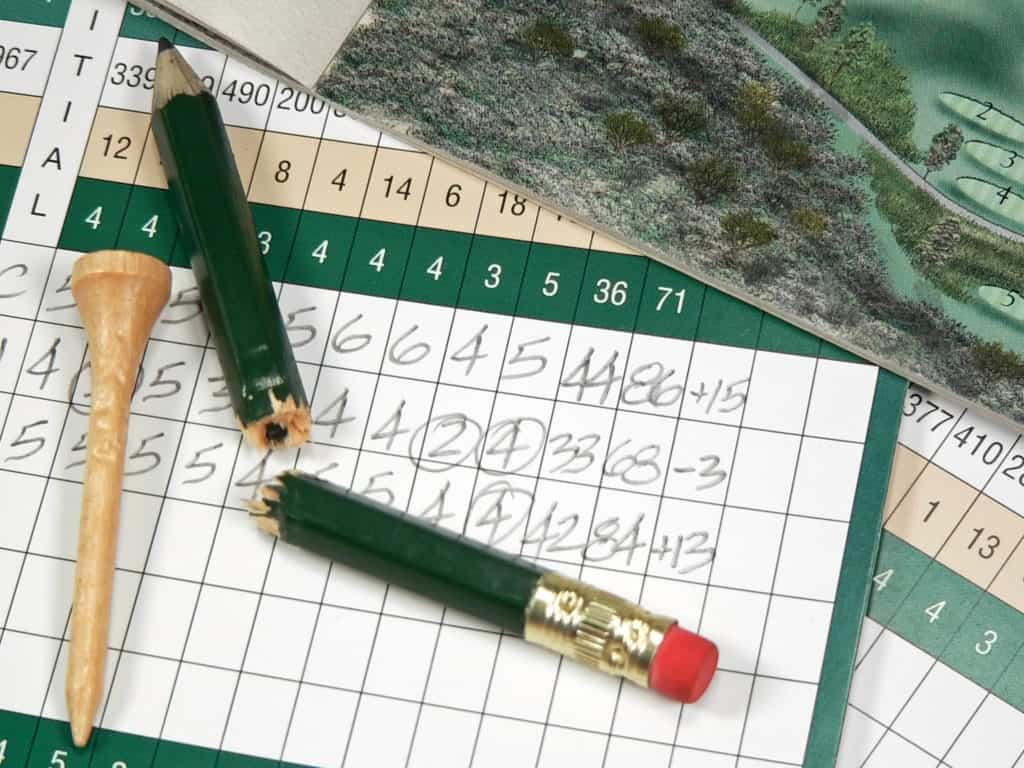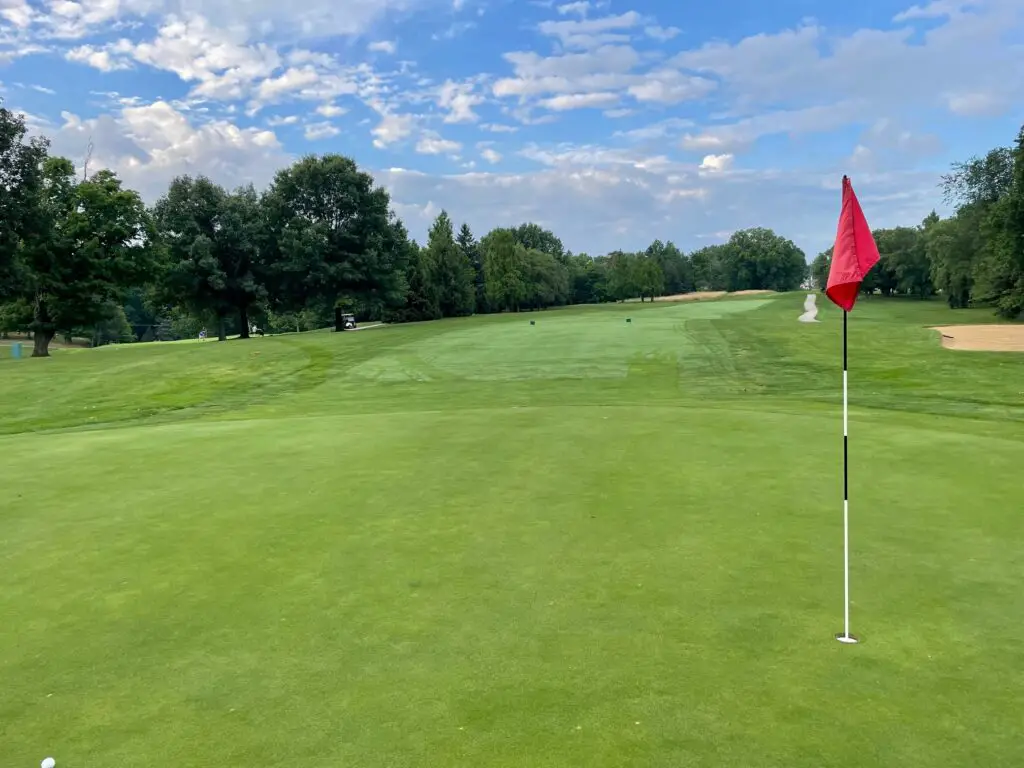Golf can be a complicated game.
There are many areas of the game the golfer can pursue to improve his or her score.
Our list below is our top 7 areas we believe golfers should focus on to truly improve their score. We believe that too many golfers spend way too much time working on making their swing look aesthetically pleasing vs creating a swing that they own and can be counted on.
If a golfer is working on his or her swing, they should be building skill to develop their golf swing in one of the following areas:
- Low Point Control: Golfers need to make solid contact. The better low point control, the better the quality of the strike throughout the bag.
- Start Line and Curve: The golfer also needs to control the start line of their shot and the direction the ball will curve. The best golfers typically hit a stock shot that they can count on.
- Speed: The golfer needs to have enough distance to play the course. This often comes from having a high enough swing speed.
7 Scoring Tips for Golfers
- Keep the ball in play
- Strike your irons solid
- Avoid 3 putts
- Chip the ball consistently
- Practice your 3-10 footers
- Avoid bogeys on par 5s
- Avoid double bogeys

Tip #1: Keep the ball in play
The most devastating shot in golf is the tee shot that goes out of bounds. The golfer is now hitting 3 from the tee and is looking at double bogey or worse. If you hit 1-3 of these per round, your score is going to be significantly higher than the golfer that can keep the ball in play.
We would recommend developing two different driver swings. The first one is your regular driver swing, controlled, but with some quality swing speed. This driver swing can be used when there is space to miss on one side of the hole.
The second swing is a “bunt” swing. This is a 70-80% swing with accuracy as your primary goal
My first swing travels around 270-280 yards with my “bunt” swing traveling between 240-260 yards. Just the other day I played a course with out of bounds or a hazard on both sides of every hole. I hit the “bunt” swing for every driver. I was still able to shoot in the mid 70s due to keeping the ball in play.
Over time, you will see when to use what shot and much it is based on how you are swinging that day. Be a player and make adjustments as needed during your round and over the course of a season.
Tip #2: Strike your irons solid
When you can strike your irons solid, you keep the ball moving forward at the distance you intended. The iron shot that comes up 10-30 yards short due to a fat or thin shot can cost penalty strokes and leaves you with a long next shot.
However, if you can carry the ball a certain distance a high percentage of the time, you leave yourself with decent chips that allow you to make a par or bogey at worse. Keeping the ball in play and striking it solid are two keys every golfer needs to continue to work on and most can always improve.

Tip #3: Avoid 3 Putts
We all have been there! We hit a solid drive, followed by a crisp iron, only to leave 3 putt from 30 feet or so. In order to avoid 3 putts, we must get good at putts from 30-40 feet and putts inside of 10 feet. Too many golfers never practice putting and instead simply hit balls at the driving range. Make sure you are balancing your practice time with all facets of the game.
Tip #4: Chip the ball consistently
Chances are that amateurs will miss more than 50% of the greens in regulation. This results in 9 or more chips shots per round. If we can get good at chipping inside of 10 feet and then making 50% of those putts, we can lower our scores quickly.
The great news about chipping, much like putting, is that it doesn’t take a great deal of athletic ability, strength or overall speed to be a great short game player. Instead, it takes some basic technique with hours of practice.

Tip #5: Practice your 3-10 footers
We touched briefly on this in the 3 putt avoidance category, but those 3-10 footers are round savers and help you keep your mind right. Stick a wedge to 10 feet and make a birdie putt and you feel great heading to the next tee. Hit a 7 iron to 30 feet and 3 putt and you are angry and frustrated with your game.
Use different drills to work on those 3-10 footers, but maintain your expectations. Understanding that professional golfers only make around 50% of their 8 foot putts. Practice and gain an edge over your competition!
Tip #6: Avoid bogeys on par 5s
The par 5s should be your scoring holes. Depending on your current skill level, you might be able to make 1-2 birdies on the par 5s over a round, but we must also avoid he 6 or higher on the par 5s. Keep the ball in play, advance it down the fairway and for the most part you have turned a 500 yard par 5 into a short par 3 with a wedge in your hand. Do this over the 4 par 5s you will find on most courses and your scores will improve and your attitude about your game will remain positive!

Tip #7: Avoid double bogeys
The formula is simple. Keep the ball in play, avoid 3 putts and chances are you will avoid double bogeys. Double bogeys are often the result of poor management. For example, golfer A hits the ball in the trees and can reasonably advance the ball to within 75 yards of the hole. He decides to punch the ball to this distance, hits the grene from 75 yards and two putts for a bogey.
Golfer B has the same shot, but sees a gap in the trees. He tries to pull this shot off, but hits a tree and the ball is still in the trees. He is staring right at a double bogey or worse depending on how he handles his emotions.
Play it smart, avoid the double bogeys. If you hit a poor tee shot, take your bogey and head to the next hole and work on getting better off the tee.
BONUS TIP: Train for Speed
The game of golf has evolved to where speed is important in the game of golf. The faster your swing, the further the ball flies and the more shorter irons or wedges you have into a green.
Training for speed is a great idea and one worth exploring!
My bunt swing example above can be a great swing because I have enough in my swing to still hit the ball far enough with a bunt swing.
If you are going to train for speed, I would highly recommend the SuperSpeed Training System.
Gone are the days of simply being content with the distance you currently hit your golf ball. Many older golfers have proven over the past several years that an increase in swing speed is possible.
There are training systems to help you get your game to the next level and distance is arguably the fastest way to make this happen!
My number one recommendation is to check out SuperSpeed Golf and their protocols to help you find a safe way to increase your swing speed.
I spent many years wondering how I can increase my swing speed. When I was playing junior golf, we weren’t fortunate enough to have some of the training aids and knowledge that is now available. Smart people have studied the golf swing and have created training aids and protocols to help all golfers increase their distance!
At around the same time, the statistics from the PGA Tour have become more clear and the importance of speed is acknowledged by many to be a key to being the best on the PGA Tour.
Within the past several years, there have been several products hit the market to make speed gains possible. While many people for many years waited for the latest driver to come out to gain an additional 5-10 yards, you can now do this even with your current clubs.
Did you know that with the SuperSpeed Training System you can gain 5-8% increase in swing speed as early as the first training session? This would allow you to gain somewhere between 10 and 30 yards depending on your current swing speed.
The SuperSpeed Training System is based on three different swing speed sticks all weighing at different weights. There is a green club that is 10% lighter than the average driver, the blue club which is 5% lighter and the red club which is actually 5% heavier!
Following their prescribed protocols the golfer completes the training every other day. The total time to complete most of their protocols is between 10-15 minutes. Most people can find the time to make this happen. The golfer will also need a swing radar to measure their progress.
The science behind the SuperSpeed Training System is based on overspeed training. Overspeed training has been around for several decades now and has been used by olympic athletics in the sport of Track and Field.
The science behind this overspeed training is based on the premise that your brain will only allow your body to move as fast as it feels it can stop safely! So, you get to work and swing the clubs as fast as possible, retraining your brain to allow you to swing your driver faster.
For more permanent results, the golfer should continue these training protocols for several months. The initial 5-8% is great and can become more permanent with the right length of training. The golfer can expect to continue to break down barriers every several months at a 1-2% increase.
My own experience has been an increase of 7-10 miles per hour on average from between 98-101 all the way up to 106-109. My goal is to hit the PGA Tour average of 113 mph in the coming months. I will continue to train every other day and watch in amazement as I am hitting drivers longer now than ever before!
Phil Mickelson (a senior golfer now) has been known to increase his swing speed in the past year or so and is close to 120 miles per hour in his swing speed. There are potential results for golfers of all ability levels and age!
Check the current price on SuperSpeed Golf System, here!
| Original Swing Speed | After 4-6 Weeks | New Carry Distance | Total Distance |
| 95 | 102 | 245 | 265 |
| 100 | 108 | 259 | 279 |
| 105 | 113 | 271 | 291 |
| 110 | 118 | 283 | 303 |
Final Thoughts
I would highly recommend reviewing the 7 tips above and then get to work on speed, low point control and a stock shot. Build these skills, manage your game and you will shoot lower scores.
Building skill in these areas is important. Here are some links to help you in each of these 3 key areas:
My Secret To Golf Improvement
Let’s face it, in order to get really good at golf, we must practice frequently. About three years ago, I made the leap and invested in a golf simulator build for my garage. I went with a SkyTrak Launch Monitor and the TGC software and can now play over 100,000 courses including Augusta, Pebble Beach, Bethpage Black, Whistling Straits. St. Andrews and many other of the top 100 courses in the world.
This golf simulator setup, which is more affordable that you might imagine, has been a game changer. I can now play golf everyday of the year regardless of rain, snow, cold weather or time of day. I can practice or play rounds of golf. I can stand in the 11th fairway at Augusta and with the auto-rewind feature I am able to practice my approach shots from various differences.
It is worth checking out through Rain or Shine Golf as they offer some incredible packages along with financing offers that are difficult to beat.
Some direct links to Rain or Shine Golf for pricing and financing:
Take Action – What You Can Do Today to Get Better
What does this mean for you? I believe in the following recipe to get better:
1 – Improve your motion in the golf swing by identifying a golf instructor. Here are some options:
Here is a list of golf instructors that we have reviewed:
2 – Train to swing faster and improve your swing speed. Here are some options:
Looking to gain more Speed and Distance in your swing. Two Options:
3 – Understand course strategy and work to break through your next barrier. Here is a series on breaking through:
We have provided guides on how to break 100, 90, 80 and 70. Check out more below, if interested.
4 – Practice Frequently
Did you know that I build a golf simulator in my garage and have played over 500 rounds of golf on my SkyTrak system? It has been a game changer and one worth checking out. Here are some of my other posts on golf simulators frequently asked questions:
- Is a Golf Simulator Worth It?
- How to Build a Golf Simulator?
- What is the Best Golf Simulator?
- Golf Simulator Accessories?
- How to Build a Golf Simulator for under $7000
- Top 11 Reasons to Buy a SkyTrak
- How to Build a Golf Simulator for Under $1000
- Why Build A Golf Simulator?
- What Space is Needed?
- Can A Golf Simulator Improve My Game?
- How Much Does A Golf Simulator Cost?
- Don’t Forget to Check out our 15 best golf swings of all time.
I am an amateur golfer on a journey to get better, enjoy the game as often as possible and share my passion and knowledge with others. I have coached high school golfers at a high level and have a great passion for the game and want to give back. I enjoy learning about the golf swing and am currently studying to be a certified professional golf instructor. Join me in our journey to get better everyday.

